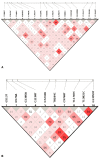Genome-wide study of globally distributed respiratory syncytial virus (RSV) strains implicates diversification utilizing phylodynamics and mutational analysis
- PMID: 37598270
- PMCID: PMC10439963
- DOI: 10.1038/s41598-023-40760-y
Genome-wide study of globally distributed respiratory syncytial virus (RSV) strains implicates diversification utilizing phylodynamics and mutational analysis
Abstract
Respiratory syncytial virus (RSV) is a common respiratory pathogen that causes mild cold-like symptoms and severe lower respiratory tract infections, causing hospitalizations in children, the elderly and immunocompromised individuals. Due to genetic variability, this virus causes life-threatening pneumonia and bronchiolitis in young infants. Thus, we examined 3600 whole genome sequences submitted to GISAID by 31 December 2022 to examine the genetic variability of RSV. While RSVA and RSVB coexist throughout RSV seasons, RSVA is more prevalent, fatal, and epidemic-prone in several countries, including the United States, the United Kingdom, Australia, and China. Additionally, the virus's attachment glycoprotein and fusion protein were highly mutated, with RSVA having higher Shannon entropy than RSVB. The genetic makeup of these viruses contributes significantly to their prevalence and epidemic potential. Several strain-specific SNPs co-occurred with specific haplotypes of RSVA and RSVB, followed by different haplotypes of the viruses. RSVA and RSVB have the highest linkage probability at loci T12844A/T3483C and G13959T/C2198T, respectively. The results indicate that specific haplotypes and SNPs may significantly affect their spread. Overall, this analysis presents a promising strategy for tracking the evolving epidemic situation and genetic variants of RSV, which could aid in developing effective control, prophylactic, and treatment strategies.
© 2023. Springer Nature Limited.
Conflict of interest statement
The authors declare no competing interests.
Figures





References
-
- Jain, H., Schweitzer, J.W. & Justice, N.A. Respiratory Syncytial Virus Infection. in StatPearls (StatPearls Publishing Copyright © 2022, StatPearls Publishing LLC., Treasure Island (FL), 2022). - PubMed
-
- McLaurin, K. & Leader, S. Growing impact of RSV hospitalizations among infants in the US, 1997–2002. in Pediatric Academic Societies’ Meeting 14–17 (2005).
Publication types
MeSH terms
LinkOut - more resources
Full Text Sources

